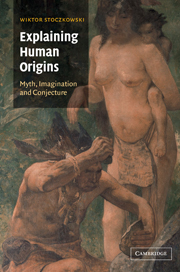Book contents
- Frontmatter
- Contents
- List of tables
- Acknowledgements
- Introduction: in which the author briefly explains his aims
- 1 Prehistory and the conditioned imagination
- 2 Anthropogenesis and science
- 3 In search of causes
- 4 Evolutionary mechanisms: the constraints of nature or of imagination?
- 5 A double game
- Bibliography
- Index
4 - Evolutionary mechanisms: the constraints of nature or of imagination?
- Frontmatter
- Contents
- List of tables
- Acknowledgements
- Introduction: in which the author briefly explains his aims
- 1 Prehistory and the conditioned imagination
- 2 Anthropogenesis and science
- 3 In search of causes
- 4 Evolutionary mechanisms: the constraints of nature or of imagination?
- 5 A double game
- Bibliography
- Index
Summary
The general is honoured because it reveals the cause.
Aristotle, Posterior analytics 88a 5COMMON SENSE AND EVOLUTION
A study of the components and ‘causal’ relations that form the structural framework of our scenarios gives only a fragmented image of the way they are constructed, since each of the explanatory sequences also presupposes a mechanism for evolutionary change. In this regard, the explanations can be divided into three groups:
‘Traditional’ explanations, which appeal neither to the mechanisms of Darwinian evolution nor to ‘Lamarckian’ principles.
‘Lamarckian’ explanations, which refer, explicitly or not, to the principle of use and disuse, as well as to the inheritance of acquired characteristics.
‘Darwinian’ explanations, in which I have included those that allude to the mechanisms of natural and sexual selection, or, more generally, those that have recourse to Darwinian terminology (for example, the terms of fitness, preadaptation, etc.), indeed even to a terminology commonly considered as such (for example the notion of adaptation). A separate group in this category consists of explanations that refer to the mechanism of ‘correlated variation’ or ‘correlation of growth’.
The logicist reconstruction to which all the hominisation scenarios have been subjected enables us to distinguish a total of 216 explanatory sequences, each expressed by one or more inferential operations. Since the authors under consideration (leaving Lamarck aside, of course) proclaim their attachment to the Darwinian or neo-Darwinian theory of evolution, it is surprising to find that almost 74 per cent of the causal sequences make no reference to Darwinian mechanisms.
- Type
- Chapter
- Information
- Explaining Human OriginsMyth, Imagination and Conjecture, pp. 131 - 167Publisher: Cambridge University PressPrint publication year: 2002



